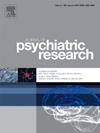Modulation of neuroinflammation and oxidative stress by Echinacea purpurea extract: Therapeutic potential in maternal separation-induced autism spectrum disorder
IF 3.7
2区 医学
Q1 PSYCHIATRY
引用次数: 0
Abstract
Background
Autism Spectrum Disorder (ASD) is defined by ongoing problems in social interaction and communication and repetitive, constrained behavior patterns. The link between oxidative stress (OS) and inflammation with ASD has been shown in previous studies. E. purpurea is well-known for its potential antioxidant and anti-inflammatory pharmacological properties. In this study, we aimed to evaluate the effects of E. purpurea hydroalcoholic extract on autistic-like behaviors following a mouse model of maternal separation (MS) stress, focusing on possible anti-neuroinflammation and antioxidative stress.
Methods
70% hydro-ethanolic extract was macerated from the aerial parts of E. purpurea. Standardization was done by determining the amount of chicoric acid in the extract using the UHPLC method. Then, behavioral analysis was done on 75 male mice that underwent MS. Mice were treated with normal saline or 75, 150, and 300 mg/kg of the extract. Sociability behaviors and stereotyping behaviors have been evaluated. Also, their total antioxidant capacity (TAC), nitrite levels, and malondialdehyde (MDA) were measured in the hippocampus. In addition, the expression of inflammatory factors, including interleukin-1 (IL-1), NLRP3, and TLR4, has been determined by quantitative real-time PCR (qRT-PCR). Data were analyzed after collection using PRISM statistical software.
Results
Our findings indicated that MS caused autistic-like behaviors in mice (increased sociability index and social preference index) and increased repetitive behaviors (increased number of buried marbles). These autistic-like behaviors are associated with increased MDA, nitrite, over-expression of inflammatory genes, decreased MDA, nitrite, over-expression of inflammatory genes, and decreased TAC in the hippocampus. E. purpurea extract significantly reversed these adverse effects of MS.
Conclusion
The results of this study showed that E. purpurea extract might reduce autistic-like behaviors in MS by attenuating neuroinflammation and oxidative stress states.
求助全文
约1分钟内获得全文
求助全文
来源期刊

Journal of psychiatric research
医学-精神病学
CiteScore
7.30
自引率
2.10%
发文量
622
审稿时长
130 days
期刊介绍:
Founded in 1961 to report on the latest work in psychiatry and cognate disciplines, the Journal of Psychiatric Research is dedicated to innovative and timely studies of four important areas of research:
(1) clinical studies of all disciplines relating to psychiatric illness, as well as normal human behaviour, including biochemical, physiological, genetic, environmental, social, psychological and epidemiological factors;
(2) basic studies pertaining to psychiatry in such fields as neuropsychopharmacology, neuroendocrinology, electrophysiology, genetics, experimental psychology and epidemiology;
(3) the growing application of clinical laboratory techniques in psychiatry, including imagery and spectroscopy of the brain, molecular biology and computer sciences;
 求助内容:
求助内容: 应助结果提醒方式:
应助结果提醒方式:


